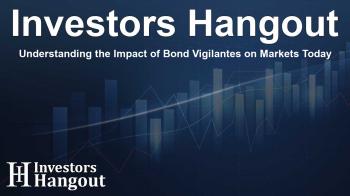Understanding the Impact of Bond Vigilantes on Markets Today

The Role of Bond Vigilantes in Today's Economy
Growing concerns over government expenditure have become a prominent topic among policymakers and investors alike. Many major economies, including those in the U.S., Britain, and France, are increasingly leaning on bond markets to support their financial activities, prompting discussions about the rising influence of bond vigilantes once again.
The Current Landscape of the Bond Market
This year marks a notable selloff in the global government bond markets, with Britain prominently affected. The inability of France to enforce austerity measures due to political instability has further strained its standing with investors. Simultaneously, rising yields on U.S. Treasuries reveal investor skepticism regarding whether the U.S. government will effectively tackle its growing budget deficit.
Who Are Bond Vigilantes?
The term 'bond vigilantes' originated in the 1980s and describes investors who impose fiscal discipline on governments viewed as excessive in their spending habits by demanding higher yields on debt. This discontent can also be seen in broader monetary policies; when investors feel that inflation is not being adequately controlled, they seek higher returns to compensate for perceived risk.
The Ripple Effects of Increasing Borrowing Costs
When the cost of government borrowing increases, this can cause lending rates for consumers and businesses to rise, consequently threatening economic stability if these costs continue to escalate. The scenario is particularly alarming for economies where borrowing is already under scrutiny.
The Shift in Economic Priorities
Historically, in the 1990s, bond markets saw relative calm as the U.S. government prioritized budget balancing, resulting in eased investor fears. However, central bank interventions, particularly post the 2007-2008 financial crisis, contributed to a sustained period of low borrowing costs.
Recent Changes That Amplify Investor Influence
In recent years, a surge in inflation has sparked renewed investor scrutiny, especially with increased government spending during the pandemic and the energy crisis fueled by geopolitical tensions. As central banks retreat from the bond market, the critiques and influence of bond vigilantes are resurging.
The Present Dilemmas in the Bond Markets
As of now, the focus has shifted from inflation concerns in the 1980s to the pressing issue of rising government debt. The U.S. budget deficit has ballooned to significant proportions, and Britain's government debt has reached a critical threshold, overtaking its economic output. Meanwhile, Germany stands as the only G7 nation maintaining a debt ratio below the 100% mark.
Recent Examples of Market Responses
A stark illustration of the bond vigilantes' influence can be observed in Britain where borrowing costs rose dramatically following unfavorable fiscal announcements. The swift rise in yields forced a policy shift and resulted in the resignation of Prime Minister Liz Truss. Similar instances have occurred in France, where political instability led to increased lending costs compared to safer German bonds.
The Strength of Bond Vigilantes Reassessed
Historically, bond vigilantes have proven powerful, particularly as debt levels have escalated markedly in recent times. The total value of U.S. Treasuries has now reached approximately $28 trillion, a considerable rise from pre-pandemic levels.
Considering the Future of Bond Vigilantes
While bond vigilantes have made significant waves in Britain, their influence in the U.S. and France remains limited despite well-documented spending concerns. Analysts observe that rising U.S. Treasury yields may illustrate investor apprehensions regarding forthcoming fiscal policies, particularly with a new administration's spending plans on the horizon.
Frequently Asked Questions
What are bond vigilantes?
Bond vigilantes are investors who react to perceived fiscal irresponsibility by demanding higher yields on government debt, imposing discipline on spending.
How do bond vigilantes affect borrowing costs?
When bond vigilantes raise their required yields, it increases government borrowing costs, which can lead to higher rates for consumers and businesses, fostering economic instability.
Why are bond vigilantes becoming more relevant today?
Growing government debts and rising inflation concerns without adequate central bank intervention have reignited the importance of bond vigilantes in financial markets.
What historical events have shaped the role of bond vigilantes?
The concept began gaining traction in the 1980s, but the influence fluctuated, particularly influenced by U.S. government policies and global financial crises.
Are bond vigilantes a global phenomenon?
Yes, while notably impactful in the U.S. and Britain, bond vigilantes affect global markets and economies, especially during periods of political and financial instability.
About The Author
Contact Dylan Bailey privately here. Or send an email with ATTN: Dylan Bailey as the subject to contact@investorshangout.com.
About Investors Hangout
Investors Hangout is a leading online stock forum for financial discussion and learning, offering a wide range of free tools and resources. It draws in traders of all levels, who exchange market knowledge, investigate trading tactics, and keep an eye on industry developments in real time. Featuring financial articles, stock message boards, quotes, charts, company profiles, and live news updates. Through cooperative learning and a wealth of informational resources, it helps users from novices creating their first portfolios to experts honing their techniques. Join Investors Hangout today: https://investorshangout.com/
The content of this article is based on factual, publicly available information and does not represent legal, financial, or investment advice. Investors Hangout does not offer financial advice, and the author is not a licensed financial advisor. Consult a qualified advisor before making any financial or investment decisions based on this article. This article should not be considered advice to purchase, sell, or hold any securities or other investments. If any of the material provided here is inaccurate, please contact us for corrections.

